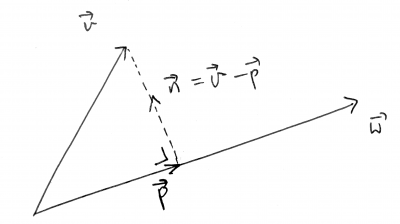Last time
- Dot product: $\vec v\cdot\vec w=v_1w_1+v_2w_2+\dots + v_nw_n$
- Geometric formula: $\vec v\cdot \vec w = \|\vec v\|\,\|\vec w\|\,\cos\theta$
- $\|\vec v\|=$length of $\vec v$ $=\sqrt{v_1^2+\dots+v_n^2}$
- $\|\vec w\|=$length of $\vec w$ $=\sqrt{w_1^2+\dots+w_n^2}$
- $\theta=$angle between $\vec v$ and $\vec w$
- $\vec v$ and $\vec w$ are orthogonal (at right-angles) if $\vec v\cdot \vec w=0$
Orthogonal projection
Let $\def\pp{\vec p}\def\ww{\vec w}\def\vv{\vec v}\def\nn{\vec n}\ww$ non-zero, and $\vv$ any vector.
$\pp$ is the orthogonal projection of $\vv$ onto $\ww$ if:
- $\pp$ is in the same direction as $\ww$; and
- the vector $\nn=\vv-\pp$ is orthogonal to $\ww$.
- We write $\pp=\def\ppp{\text{proj}_{\ww}\vv}\ppp$.
- $\nn=\vv-\pp$ is called the component of $\vv$ orthogonal to $\ww$.
Formula for $\pp=\ppp$
- $\nn=\vv-\pp$ is orthogonal to $\ww$, so $\nn\cdot \ww=0$.
- so $(\vv-\pp)\cdot \ww=0$
- so $\vv\cdot\ww-\pp\cdot\ww=0$
- so $\pp\cdot\ww=\vv\cdot\ww$
- $\pp$ in same direction as $\ww$, so $\color{blue}{\pp=c\ww}$ for some scalar $c$
- so $c\ww\cdot \ww=\vv\cdot\ww$
- so $c\|\ww\|^2=\vv\cdot\ww$
- so $c=\frac{\vv\cdot\ww}{\|\ww\|^2}$.
- So $\color{blue}{\pp=\ppp=\frac{\vv\cdot\ww}{\|\ww\|^2}\ww}.$
Example
$\vv=\def\c#1#2#3{\left[\begin{smallmatrix}#1\\#2\\#3\end{smallmatrix}\right]}\c12{-1}$ and $\ww=\c2{-1}4$
- $\ppp=\frac{\vv\cdot\ww}{\|\ww\|^2}\ww$
- $=\frac{2-2-4}{2^2+(-1)^2+4^2}\c2{-1}4$
- $=-\frac4{21}\c2{-1}4$
- component of $\vv$ orthogonal to $\ww$ is $\nn=\vv-\ppp$
- $\nn=\c12{-1}-\left(-\frac4{21}\right)\c2{-1}4=\frac1{21}\c{29}{38}{-5}$.
The cross product of vectors in $\mathbb{R}^3$
The standard basis vectors in $\mathbb{R}^3$
- Define $\def\i{\vec \imath}\i=\def\c#1#2#3{\left[\begin{smallmatrix}#1\\#2\\#3\end{smallmatrix}\right]}\c100$, $\def\j{\vec \jmath}\j=\c010$ and $\def\k{\vec k}\k=\c001$.
- These are the standard basis vectors of $\mathbb{R}^3$.
- Any vector $\vec v=\c{v_1}{v_2}{v_3}$ is a linear combination of these vectors
- (that is, a sum of scalar multiplies of $\i$, $\j$ and $\k$)
- because\[ \def\vc#1{\c{#1_1}{#1_2}{#1_3}}\vec v=\vc v=\c{v_1}{0}{0}+\c{0}{v_2}{0}+\c{0}{0}{v_3} = v_1\i+v_2\j+v_3\k.\]
The cross product
- Let $\def\vc#1{\left[\begin{smallmatrix}#1_1\\#1_2\\#1_3\end{smallmatrix}\right]}\vec v=\vc v$ and $\vec w=\vc w$ be vectors in $\mathbb{R}^3$
- $\vv\times\ww$ is another vector in $\mathbb{R}^3$, the cross product of $\vv$ and $\ww$
- … defined as the determinant $\color{blue}{\vv\times\ww=\def\cp#1#2#3#4#5#6{\left|\begin{smallmatrix}\i&\j&\k\\#1\\#4\end{smallmatrix}\right|}\def\cpc#1#2{\cp{#1_1}{#1_2}{#1_3}{#2_1}{#2_2}{#2_3}}\cpc vw.}$
- Interpret this by Laplace expansion along row 1:\[\cpc vw=\def\vm#1{\left|\begin{smallmatrix}#1\end{smallmatrix}\right|}\vm{v_2&v_3\\w_2&w_3}\i-\vm{v_1&v_3\\w_1&w_3}\j+\vm{v_1&v_2\\w_1&w_2}\k=\c{v_2w_3-v_3w_2}{-(v_1w_3-v_3w_1)}{v_1w_2-v_2w_1}\]
Example
Let $\vv=\c13{-1}$ and $\ww=\c21{-2}$.
- $\vv\times \vv=\cp13{-1}13{-1}=\c000=\vec0$
- $\vv\times\ww=\cp13{-1}21{-2}=\c{3(-2)-1(-1)}{-(1(-2)-(-1)2)}{1(1)-3(2)}=\c{-5}0{-5}$
- $\ww\times\vv=\cp21{-2}13{-1}=\c{1(-1)-(-2)3}{-(2(-1)-(-2)1)}{2(3)-1(1)}=\c{5}0{5}=-\vv\times\ww$
Example: cross products of standard basis vectors
We have \[ \i\times\j=\cp100010=\c001=\k,\] \[ \j\times\k=\cp010001=\c100=\i\] \[ \k\times\i=\cp001100=\c010=\j\]
Proposition: properties of the cross product
For any $\def\uu{\vec u}\uu$, $\vv$ and $\ww$ in $\mathbb{R}^3$ and any $c\in\mathbb{R}$:
- $\uu\times(\vv+\ww)=\uu\times\vv+\uu\times\ww$
- $\vv\times\ww=-\ww\times\vv$
- $(c\vv)\times \ww=c(\vv\times\ww)=\vv\times(c\ww)$
- $\vv\times\vv=\vec0$
- $\vv\times \vec0=\vec0$
- $\vv\times \ww$ is orthogonal to both $\vv$ and $\ww$
Proof
- Calculations/properties of the determinant.
Theorem: cross and dot product formula
For any vectors $\vv$ and $\ww$ in $\mathbb{R}^3$, we have \[ \|\vv\times\ww\|^2+(\vv\cdot\ww)^2=\|\vv\|^2\,\|\ww\|^2.\]
The proof is a calculation, which we leave as an exercise.
Corollary: the length of $\vec v\times\vec w$
For any vectors $\vv$ and $\ww$ in $\mathbb{R}^3$, we have \[ \|\vv\times\ww\|=\|\vv\|\,\|\ww\|\,\sin\theta\] where $\theta$ is the angle between $\vv$ and $\ww$ (with $0\le\theta\le\pi$).
Proof
- Geometric dot product formula: $\vv\cdot\ww=\|\vv\|\,\|\ww\|\cos\theta$
- $\times$ & $\cdot$ formula: $\|\vv\times\ww\|^2+(v\cdot w)^2=\|\vv\|^2\,\|\ww\|^2$
- So $\|\vv\times\ww\|^2=\|\vv\|^2\,\|\ww\|^2-(\vv\cdot\ww)^2$
- $=\|\vv\|^2\,\|\ww\|^2-\|\vv\|^2\|\ww\|^2\cos^2\theta$
- $=\|\vv\|^2\,\|\ww\|^2(1-\cos^2\theta)$
- $=\|\vv\|^2\,\|\ww\|^2\sin^2\theta$.
- $\sin\theta\ge0$ for $0\le\theta\le\pi$, so taking square roots of both sides gives $ \|\vv\times\ww\|=\|\vv\|\,\|\ww\|\,\sin\theta$. ■
Geometry of the cross product
The area of a triangle
- Consider a triangle with two sides $\vv$ and $\ww$
- Think of $\vv$ as the base.
- Length of the base is $b=\|\vv\|$
- Height (at right angles to base) is $h=\|\ww\|\sin \theta$ where $\theta$ is the angle between $\vv$ and $\ww$.

- Hence area of this triangle is $A=\tfrac12 bh=\tfrac12\|\vv\|\,\|\ww\|\sin\theta$
- So $A=\tfrac12\|\vv\times\ww\|$.
The area of a parallelogram
Consider a parallelogram, two of whose sides are $\vv$ and $\ww$.

- area is double the area of the triangle above
- So its area is $A=\|\vv\times\ww\|$.
Example
A triangle with two sides $\vv=\c13{-1}$ and $\ww=\c21{-2}$ has area
- $\tfrac12\|\vv\times\ww\|$
- $=\tfrac12\left\|\c13{-1}\times\c21{-2}\right\|$
- $=\tfrac12\left\|\c{-5}0{-5}\right\|=\tfrac52\left\|\c{-1}0{-1}\right\|=\tfrac52\sqrt2$.
The parallelogram with sides $\vv$ and $\ww$ has area
- $\|\vv\times\ww\|=5\sqrt2$.
The volume of a parallelepiped in $\mathbb R^3$
Consider a parallelepiped, with three sides given by $\uu,\vv,\ww$.

- Volume is $V=\left|\det\left[\begin{smallmatrix}u_1&u_2&u_3\\v_1&v_2&v_3\\w_1& w_2&w_3\end{smallmatrix}\right]\right|$
Proof
- Area of base (parallelogram): $A=\|\vv\times\ww\|$
- Volume is $V=Ah$ ($h=$ height, measured at right-angles to the base).
- $\vv\times\ww$ is at right-angles to base
- So $h$ is the length of $\vec p=\text{proj}_{\vv\times\ww}\uu$
- So $ h=\|\text{proj}_{\vv\times\ww}\uu\|=\left\|\frac{\uu\cdot(\vv\times\ww)}{\|\vv\times\ww\|^2}\vv\times\ww\right\| = \frac{|\uu\cdot(\vv\times\ww)|}{\|\vv\times\ww\|}$
- So $V=Ah=|\uu\cdot (\vv\times\ww)| = \left| \det\left[\begin{smallmatrix}u_1&u_2&u_3\\v_1&v_2&v_3\\w_1& w_2&w_3\end{smallmatrix}\right]\right|.$
Example
Find volume of the parallelepiped with vertices including $A=(1,1,1)$, $B=(2,1,3)$, $C=(0,2,2)$ and $D=(3,4,1)$, where $A$ is adjacent to $B$, $C$ and $D$.
Solution
- $\vec{AB}=\c102$, $\vec{AC}=\c{-1}11$ and $\vec{AD}=\c230$ are edges
- Volume is $ V=\left|\det\left[ \begin{smallmatrix}1&0&2\\-1&1&1\\2&3&0\end{smallmatrix}\right] \right| = | 1(0-3)-0+2(-3-2)|$
- $ = |-13| = 13.$

